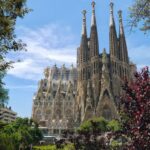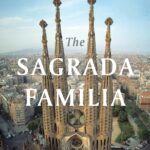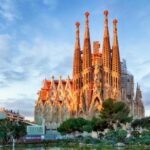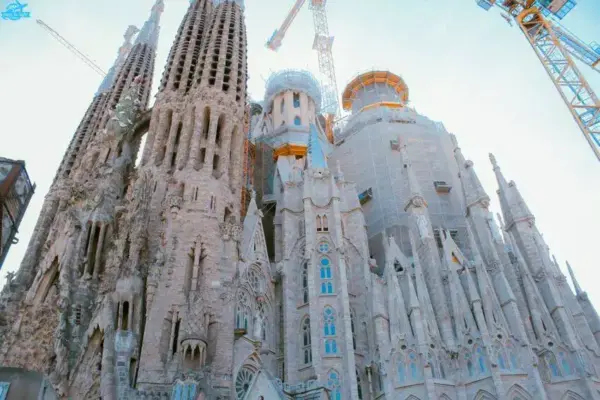
The Sagrada Familia, a masterpiece by architect Antoni Gaudí, stands as a symbol of Barcelona’s rich artistic heritage. This iconic basilica, still under construction, mesmerizes visitors with its intricate designs and towering spires, blending Gothic and Art Nouveau styles in a way that has captivated the world.
In this article, we explore The Marvels of Sagrada Familia: Unveiling Barcelona's Iconic Landmark, delving into its fascinating history, architectural innovations, and the cultural significance that makes it a must-see destination for millions of travelers each year.
Exploring the Architectural Significance of the Sagrada Familia
The architectural significance of the Sagrada Familia extends far beyond its breathtaking façade. Gaudí's innovative approach to design incorporates natural forms and structures, which reflects his deep understanding of geometry and light. The interplay of light and shadow within the basilica creates a spiritual experience, enhancing the overall ambiance and inviting contemplation among visitors.
One of the key features that highlight the genius of Gaudí is his use of hyperboloid structures. These unique forms not only provide structural stability but also serve to elevate the aesthetic value of the building. The Sagrada Familia showcases various architectural elements, including:
- Spiral Towers: Rising majestically, symbolizing the connection between heaven and earth.
- Natural Ventilation: Ingenious designs allow for airflow, reducing the need for artificial cooling.
- Integrated Nature: Gaudí incorporated organic shapes, mimicking trees and other natural elements into his designs.
The basilica's design is a harmonious blend of Gothic and Art Nouveau styles, setting it apart from traditional ecclesiastical architecture. Each of the 18 towers planned for the Sagrada Familia represents significant figures from Christianity, emphasizing its deeply spiritual context. This ambitious approach not only challenges conventional architectural norms but also resonates with the cultural identity of Barcelona.
In conclusion, the Sagrada Familia stands as a testament to innovation and creativity in architecture. Gaudí's visionary techniques and the ongoing construction efforts reflect a dedication to a living art form. As visitors explore this magnificent landmark, they witness not just a building, but a symbol of faith, culture, and artistic expression that continues to inspire future generations.
The History Behind La Sagrada Familia: A Journey Through Time
The history of La Sagrada Familia is as intricate and captivating as the basilica itself. Construction began in 1882, initiated by architect Francisco de Paula del Villar, who envisioned a traditional Gothic church. However, a year later, Antoni Gaudí took over the project, infusing it with his unique vision and innovative techniques. His commitment turned La Sagrada Familia into a lifelong endeavor, a journey that would span over a century.
Throughout its development, La Sagrada Familia has encountered various challenges and transformations. The Spanish Civil War in the 1930s brought significant setbacks, leading to the destruction of many of Gaudí's original plans and models. Despite these hardships, the project continued, driven by a passionate community and the dedication of architects who sought to honor Gaudí's legacy. The ongoing construction reflects not only the evolution of architectural styles but also the resilience of the city of Barcelona.
Today, La Sagrada Familia is expected to be completed by 2026, marking the centenary of Gaudí's death. As the basilica nears its completion, it remains a symbol of hope, faith, and the relentless pursuit of artistic excellence. Visitors can witness the fusion of traditional and modern techniques, making it a living monument to both Gaudí's genius and the enduring spirit of its creators.
In summary, the history of La Sagrada Familia is a rich tapestry woven through time, highlighting the interplay of artistic ambition and cultural devotion. Each stone tells a story of dedication and innovation, ensuring that this extraordinary landmark will continue to inspire generations to come. As it stands proudly in Barcelona's skyline, La Sagrada Familia is more than just a building; it is a testament to the power of creativity and faith.
The Artistic Mastery of Antoni Gaudí in Sagrada Familia
Antoni Gaudí's artistic mastery in the Sagrada Familia is evident in his ability to merge functionality with aesthetic beauty. His unique vision transformed traditional architectural elements into captivating forms that reflect nature's organic structures. This integration of art and design is characterized by:
- Symbolic Motifs: Each façade and sculpture tells a story, embodying biblical narratives and spiritual significance.
- Innovative Materials: Gaudí utilized locally sourced stone, allowing the basilica to blend seamlessly with Barcelona's landscape.
- Vibrant Colors: The use of stained glass creates a stunning play of light, enriching the interior with a spectrum of hues.
The Sagrada Familia showcases Gaudí's pioneering spirit, especially in his application of catenary arches and hyperbolic paraboloids. These geometrical forms not only enhance the structural integrity but also create fluidity within the space, inviting visitors to experience a sense of motion and grace. His groundbreaking techniques have laid the foundation for modern architecture, pushing the boundaries of what is possible in building design.
Moreover, the intricate details found throughout the basilica highlight Gaudí's deep reverence for nature and spirituality. From the tree-like columns in the interior to the elaborate facades adorned with sculptures, every element is meticulously crafted to reflect divine inspiration. This dedication to detail ensures that the Sagrada Familia remains a timeless piece of art, continually inviting admiration and contemplation.
In summary, Gaudí's artistic mastery is not just about the construction of a grand building; it is about creating an experience that resonates with visitors on multiple levels. The Sagrada Familia stands as a profound testament to his genius, symbolizing a harmonious blend of faith, art, and architectural innovation that will undoubtedly inspire generations to come.
Visiting Sagrada Familia: Tips for an Unforgettable Experience
Visiting the Sagrada Familia is a truly unforgettable experience, and planning ahead can enhance your time at this iconic landmark. To make the most of your visit, consider purchasing tickets online in advance. This not only helps you avoid long queues but also guarantees your entry to specific time slots, allowing for a more relaxed exploration of the basilica.
When you arrive, take a moment to admire the exquisite details of the façade before stepping inside. Early morning or late afternoon visits are ideal for capturing stunning photographs, as the natural light adds a magical quality to the architecture. Moreover, consider joining a guided tour to gain deeper insights into Gaudí's vision and the basilica's rich history.
While inside, don't miss the opportunity to explore the towers. Climbing to the top offers breathtaking panoramic views of Barcelona, providing a unique perspective on the city and its surroundings. Ensure you're comfortable with heights and check the weather, as conditions can change rapidly.
Finally, take your time to appreciate the intricate stained glass windows and the play of light within the nave. These elements create a serene atmosphere that invites contemplation. To enhance your experience, remember to observe the rules of silence and respect the spiritual significance of the space, making your visit not just a sightseeing trip, but a personal journey of discovery.
Understanding the Symbolism of Sagrada Familia's Design
The design of the Sagrada Familia is rich with symbolism, reflecting both Gaudí's artistic vision and deep spiritual convictions. Each element within the basilica serves a purpose beyond mere aesthetic appeal; it embodies the essence of faith and the divine. For instance, the spiral towers are designed to reach towards the heavens, symbolizing the connection between the earth and the celestial realm, inviting worshippers to elevate their thoughts and prayers.
Moreover, the façades of the Sagrada Familia are infused with narratives from the Bible, each telling a unique story that conveys theological themes. The Nativity Façade celebrates the birth of Jesus with intricate sculptures depicting scenes from his early life, while the Passion Façade presents a stark contrast, highlighting the themes of sacrifice and redemption. This duality reflects the core tenets of Christianity, emphasizing hope amidst suffering.
Gaudí’s use of organically inspired forms further enhances the symbolic nature of the Sagrada Familia. The interior columns resemble tree trunks, branching out to support the ceiling like a forest canopy. This design not only creates a natural environment within the basilica but also signifies the interconnectedness of all life, mirroring the divine presence in nature. Gaudí believed that nature was the ultimate source of inspiration, and this philosophy is vividly expressed throughout the structure.
In conclusion, the Sagrada Familia serves as a monumental expression of spirituality and artistic innovation. The thoughtful integration of symbolic designs and narratives within its architecture invites visitors to reflect on their own beliefs and experiences. As one navigates through this breathtaking space, the Sagrada Familia becomes more than just a landmark; it transforms into a profound journey of discovery, faith, and artistic brilliance.
The Impact of Sagrada Familia on Barcelona's Cultural Heritage
The Sagrada Familia profoundly influences Barcelona's cultural heritage, serving as a beacon of artistic expression and architectural innovation. Its unique design has catalyzed a sense of pride among locals, fostering a cultural identity that intertwines with the city's history. The basilica's ongoing construction symbolizes the dynamic nature of Barcelona, where tradition and modernity coexist harmoniously.
As a UNESCO World Heritage Site, the Sagrada Familia attracts millions of visitors each year, significantly contributing to Barcelona's economy. This influx of tourists not only supports local businesses but also highlights the city’s commitment to preserving its cultural treasures. The monument serves as a point of cultural exchange, where people from diverse backgrounds come together to appreciate Gaudí's genius and the spiritual narratives embedded in the architecture.
Furthermore, the Sagrada Familia has inspired countless artists and architects globally, prompting discussions about the importance of integrating art with functionality. Its unique features, such as the spiral towers and organic forms, encourage a renewed appreciation for craftsmanship and creativity in modern architecture. The basilica stands as a testament to how a single structure can embody the aspirations of an entire community while shaping the future of architectural practices.
Ultimately, the impact of the Sagrada Familia on Barcelona's cultural heritage extends far beyond its physical presence. It serves as a reminder of the city’s artistic roots and its ongoing journey towards a vibrant future. By preserving Gaudí's vision, Barcelona not only honors its past but also inspires future generations to explore the boundaries of creativity and spirituality. This iconic landmark is a living homage to the city's dedication to artistic excellence and cultural significance.
 Discover the Complete Sagrada Familia: Barcelona's Architectural Masterpiece
Discover the Complete Sagrada Familia: Barcelona's Architectural Masterpiece The Sagrada Familia: An In-depth Explanation of Gaudí's Masterpiece
The Sagrada Familia: An In-depth Explanation of Gaudí's Masterpiece The Fascinating Facts about Sagrada Familia: Unveiling Gaudí's Masterpiece
The Fascinating Facts about Sagrada Familia: Unveiling Gaudí's MasterpieceIf you want to know other articles similar to The Marvels of Sagrada Familia: Unveiling Barcelona's Iconic Landmark you can visit the category WHERE YOU CAN GO.
Leave a Reply










Read more!